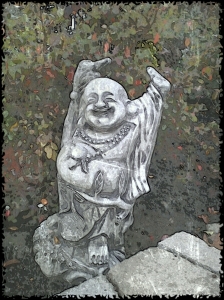Budai is traditionally depicted as an obese, bald man wearing a robe and wearing or otherwise carrying prayer beads. He carries his few possessions in a cloth sack, being poor but content. He is often depicted entertaining or being followed by adoring children. His figure appears throughout Chinese culture as a representation of contentment. His image graces many temples, restaurants, amulets, and businesses.
According to Chinese history, Budai was an eccentric Chán monk who lived in China during the Later Liang (907–923 CE). He was a native of Fenghua, and his Buddhist name was Qieci. He was considered a man of good and loving character.
The term buddha means “one who is awake”, connoting one who has awakened into enlightenment. Over the history of Buddhism, there have been several notable figures who would come to be remembered as, and referred to as, buddhas. Later followers of the Chan school would come to teach that all beings possess Buddha-nature within them, and are already enlightened, but have yet to realize it. This teaching would continue into Zen.
Budai is often conflated with (or simply replaces) the historical Buddha, Siddhartha Gautama, in spite of the distinct visual differences in how each has been depicted. In India, Nepal, and throughout southeast Asia, Gautama (who lived during the 6th century BCE) is commonly depicted as being tall and slender in appearance. In contrast, in China and those areas to which Chinese cultural influence spread, the depiction of Budai (who lived during the 10th century CE) is consistently short and round.
Folklore
Budai in folklore is admired for his happiness, plenitude, and wisdom of contentment. One belief popular in folklore maintains that rubbing his belly brings wealth, good luck, and prosperity.
In Japan, Hotei persists in folklore as one of the Seven Lucky Gods (Shichi Fukujin) of Taoism.
The laughing Buddha statue is a symbol of happiness and contentment. The Laughing Buddha is seen in different postures, each having a different significance.
*Buddha with a money bag and a gold ingot represents wealth and good fortune.
*The Standing Happy Buddha brings riches and happiness.
*Buddha sitting on a large gold nugget with a smaller nugget in his hand ready for giving to others. This position of the Laughing Buddha is symbolic of good luck.
*Buddha sitting with his fan hat on his head represents enjoyment and good fortune.
*Buddha holding a gold ingot with his hands upright signifies abundant riches and good luck.
*Buddha with a fan in one hand and wu lou (bottle gourd) in the other hand brings blessings and good health. The fan wards off misfortune while the wu lou protects from illness.
*Buddha carrying a bag of gold on his shoulder symbolizes prosperity.
*Buddha carrying a bag of blessings on his right shoulder and a fan in his left hand protects you and keeps you safe during long journeys.
*Buddha with a travel stick in his hand protects you from harm during journeys.
Buddhism
Some Buddhist traditions consider him a Buddha or a bodhisattva, often identifying him with Maitreya (the future Buddha).
His identification with the Maitreya is attributed to a Buddhist hymn he uttered before his death:
Maitreya, the true Maitreya
has billions of incarnations.
Often he is shown to people at the time;
other times they do not recognize him.
Zen
The primary story that concerns Budai in Zen (Chán) is a short kōan. In it, Budai is said to travel giving candy to poor children, only asking a penny from Zen monks or lay practitioners he meets. One day a monk walks up to him and asks, “What is the meaning of Zen?” Budai drops his bag. “How does one realize Zen?” he continues. Budai then takes up his bag and continues on his way.
I Kuan Tao
Statues of Budai form a central part of I Kuan Tao shrines, where he is usually referred to by the Sanskrit name Maitreya. According to I Kuan Tao, he represents many teachings, including contentment, generosity, wisdom and open kind-heartedness . He is predicted to succeed Gautama Buddha as the next Buddha, and helps people realize the essence within, which connects with all beings.
https://www.answers.yahoo.com/question/index?qid.com



Very informative. I often wondered why some statues were chubby like Budai and others were slimmer and more sombre/quiet in appearance.
LikeLiked by 1 person
Oh Mish I needed this happy reminder today! Thank you~
Namaste
Sindy
LikeLiked by 1 person
You’re welcome!
LikeLike
“If you’re having a bad day, I hope my blog will put a smile on your face, ease the pain you may be going through and even learn a thing or two. ”
Accomplished sister!
LikeLiked by 1 person
I appreciate your kind words!
LikeLike
Reblogged this on Sindy's Saturday Satsang and commented:
A new blogging friend, Mish, brought a smile to my heart today!
Thank you sister~
LikeLiked by 1 person
Thank you!! 🙂
LikeLike